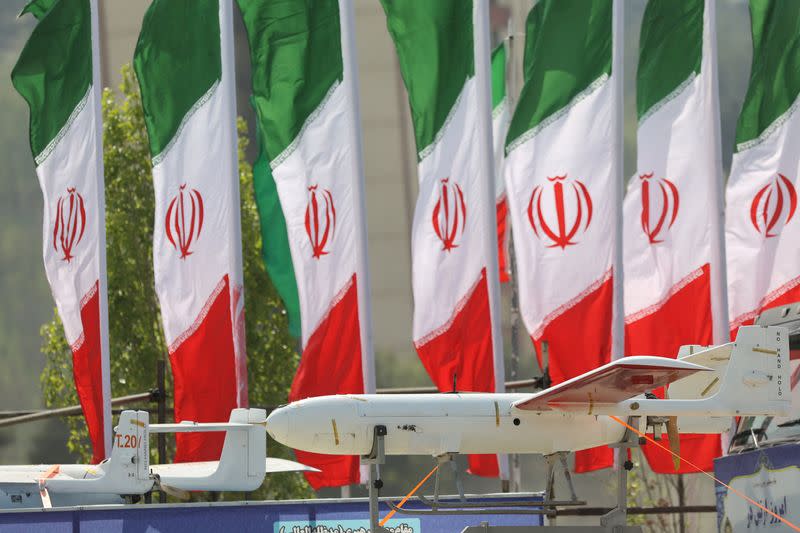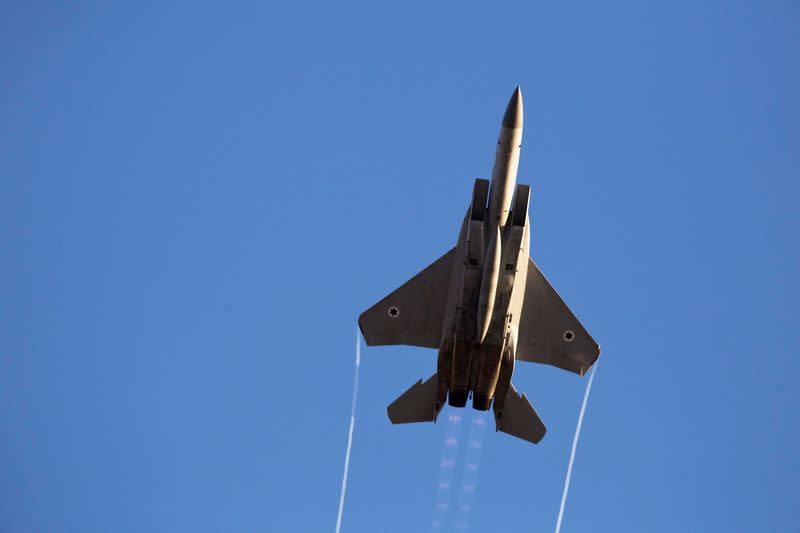Factbox-What Iran and Israel would wield in a long-range air war
JERUSALEM (Reuters) - Iran's first direct attack on Israel on April 13 has brought renewed focus on their air-defence capabilities as Israeli leaders decide how best to respond.
Below is a look at both countries' air forces and aerial defence systems:
IRAN
The Iranian air force has 37,000 personnel, but decades of international sanctions have largely cut the country off from the latest high-tech military equipment, according to the International Institute for Strategic Studies in London (IISS).
The air force only has a few dozen working strike aircraft, including Russian jets and ageing U.S. models acquired before the Iranian revolution of 1979.
Tehran has a squadron of nine F-4 and F-5 fighter jets, one squadron of Russian-made Sukhoi-24 jets, and some MiG-29s, F7 and F14 aircraft, IISS said.
The Iranians also have pilotless planes designed to fly into targets and explode. Analysts believe this drone arsenal numbers in the low thousands. In addition, they say, Iran has more than 3,500 surface-to-surface missiles, some of which carry half-tonne warheads. The number capable of reaching Israel may be lower, however.
Iran's Air force Commander, Amir Vahedi, on Wednesday said the Sukhoi-24s, were in their "best state of preparedness" to counter any potential Israeli attack.
But Iran's dependence on Sukhoi-24s jets, first developed in the 1960s, shows the relative weakness of its air force.
For defence, Iran relies on a mixture of Russian and domestically produced surface-to-air missile and air defence systems.
Tehran received deliveries of the S-300 anti-aircraft system from Russia in 2016, which are long-range surface-to-air missile systems capable of engaging multiple targets simultaneously, including aircraft and ballistic missiles.
Iran also has the domestically produced Bavar-373 surface-to-air missile platform, as well as the Sayyad and Raad defence systems.
Fabian Hinz, a research fellow at IISS, said: "If there was a major conflict between the two countries, Iran would probably concentrate on occasional successes. They don't have the comprehensive air defences that Israel has."
ISRAEL
Israel has an advanced, U.S.-supplied air force with hundreds of F-15, F-16 and F-35 multipurpose jet fighters. These played a role in shooting down Iranian drones at the weekend.
The air force lacks long-range bombers, though a smaller fleet of repurposed Boeing 707s serve as refueling tankers that could enable its fighters to reach Iran for pinpoint sorties.
A pioneer in drone technology, Israel has Heron pilotless planes capable of flying for more than 30 hours, enough for far-flung operations. Its Delilah loitering munition has an estimated range of 250 km (155 miles) - far short of the Gulf, though the air force could close the gap by delivering one of the munitions closer to Iran's border.
Israel is widely believed to have developed long-range surface-to-surface missiles, but neither confirms nor denies this. In 2018, then-Defence Minister Avigdor Lieberman announced that the Israeli military would get a new "missile force". The military has not said where those plans now stand.
A multi-layer aerial defence system developed with U.S. help after the 1991 Gulf war provides Israel will several additional options for shooting down long-range Iranian drones and missiles.
The highest-altitude system is Arrow-3, which intercepts ballistic missiles in space. An earlier model, Arrow-2, works at lower altitudes. The mid-range David's Sling counters ballistic missiles and cruise missiles, while the short-range Iron Dome tackles the kind of rockets and mortars used by Iranian-backed militias in Gaza and Lebanon - but can also, in theory, be fired at any more powerful missiles missed by Arrow or David's Sling.
The Israeli systems are designed to be patched into counterpart U.S. interceptors in the region for coalition-strength defences.
"Israel’s air defences performed well over the course of the (April 13) attack," said Sidharth Kausha, a research fellow at the Royal United Strategic Institute in London.
He noted that some of the incoming targets, particularly drones, were shot down by allied aircraft before they reached Israel, "which limited its degree of exposure to some threat types, and there appears to have been sufficient early warning to enable preparation of a coalition response which means the system was better prepared than it might have been if exposed to a similar attack with less early warning."
(Writing by Andrew MacAskill and Dan Williams)


